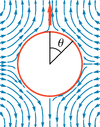Squirmer
 Shaker,  |  Pusher,  |  Neutral,  |  Puller,  |  Shaker,  |  Passive particle |
 Shaker,  |  Pusher,  |  Neutral,  |  Puller,  |  Shaker,  |  Passive particle |
| Velocity field of squirmer and passive particle (top row: lab frame, bottom row: swimmer frame) | |||||
The squirmer is a model for a spherical microswimmer swimming in Stokes flow. The squirmer model has been introduced by James Lighthill in 1952 and refined and used to model Paramecium by John Blake in 1971.[1] [2] Blake used the squirmer model to describe the flow generated by a carpet of beating short filaments called cilia on the surface of Paramecium. Today, the squirmer is a standard model for the study of self-propelled particles, such as Janus particles, in Stokes flow.[3]
Velocity field in particle frame
Here we give the flow field of a squirmer in the case of a non-deformable axisymmetric spherical squirmer (radius  ).[1][2] These expressions are given in a spherical coordinate system.
).[1][2] These expressions are given in a spherical coordinate system.


Here  are constant coefficients,
are constant coefficients,  are Legendre polynomials, and
are Legendre polynomials, and  .
.
One finds  .
.
The expressions above are in the frame of the moving particle. At the interface one finds  and
and  .
.
Swimming speed and lab frame
By using the Lorentz Reciprocal Theorem, one finds the velocity vector of the particle  . The flow in a fixed lab frame is given by
. The flow in a fixed lab frame is given by  :
:


with swimming speed  . Note, that
. Note, that  and
and  .
.
Structure of the flow and squirmer parameter
The series above are often truncated at  in the study of far field flow,
in the study of far field flow,  . Within that approximation,
. Within that approximation,  , with squirmer parameter
, with squirmer parameter  . The first mode
. The first mode  characterizes a hydrodynamic stokeslet with decay
characterizes a hydrodynamic stokeslet with decay  (and with that the swimming speed
(and with that the swimming speed  ). The second mode
). The second mode  corresponds to a hydrodynamic stresslet or force dipole with decay
corresponds to a hydrodynamic stresslet or force dipole with decay  .[4] Thus,
.[4] Thus,  gives the ratio of both contributions and the direction of the force dipole.
gives the ratio of both contributions and the direction of the force dipole.  is used to categorize microswimmers into pushers, pullers and neutral swimmers.[5]
is used to categorize microswimmers into pushers, pullers and neutral swimmers.[5]
| Swimmer Type | pusher | neutral swimmer | puller | shaker | passive particle |
| Squirmer Parameter |  |  |  |  | |
| Decay of Velocity Far Field |  |  |  |  |  |
| Biological Example | E.Coli | Paramecium | Chlamydomonas reinhardtii |
As can be seen in the figures above, the (lab frame) velocity field of the passive particle corresponds to a monopole. Furthermore, the  mode corresponds to a dipole (see case
mode corresponds to a dipole (see case  ) and the
) and the  mode corresponds to a quadrupole (see cases
mode corresponds to a quadrupole (see cases  ).
).
References
- ↑ 1.0 1.1 Lighthill, M. J. (1952). "On the squirming motion of nearly spherical deformable bodies through liquids at very small reynolds numbers". Communications on Pure and Applied Mathematics 5 (2): 109–118. doi:10.1002/cpa.3160050201. ISSN 0010-3640.
- ↑ 2.0 2.1 Blake, J. R. (1971). "A spherical envelope approach to ciliary propulsion". Journal of Fluid Mechanics 46 (01): 199. doi:10.1017/S002211207100048X. ISSN 0022-1120.
- ↑ Bickel, Thomas; Majee, Arghya; Würger, Alois (2013). "Flow pattern in the vicinity of self-propelling hot Janus particles". Physical Review E 88 (1). doi:10.1103/PhysRevE.88.012301. ISSN 1539-3755.
- ↑ Happel, John; Brenner, Howard (1981). "Low Reynolds number hydrodynamics". doi:10.1007/978-94-009-8352-6. ISSN 0921-3805.
- ↑ Downton, Matthew T; Stark, Holger (2009). "Simulation of a model microswimmer". Journal of Physics: Condensed Matter 21 (20): 204101. doi:10.1088/0953-8984/21/20/204101. ISSN 0953-8984.